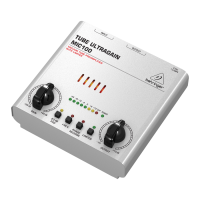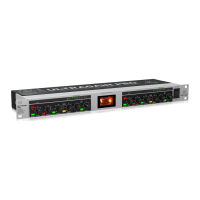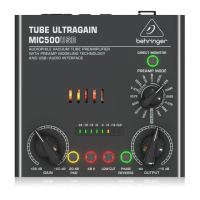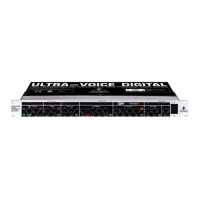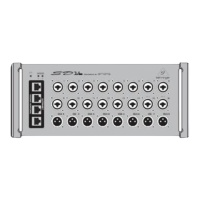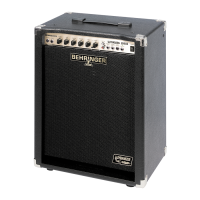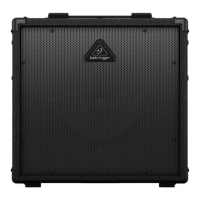Do you have a question about the Behringer ULTRAGAIN DIGITAL ADA8200 and is the answer not in the manual?
Essential safety guidelines for operating the device, including electrical, fire, and operational risks.
Statement regarding technical specifications, accuracy, and liability of MUSIC Group.
Information on warranty terms and conditions and how to check for updates online.
Specific technical condition where the ADA8200 should not be used with MOTU 2408.
Illustration and labels for the rear panel connections of the ADA8200.
Illustration and labels for the front panel connections of the ADA8200.
Diagram showing typical audio source connections to the ADA8200.
Explanation of SIG and CLIP LEDs for monitoring input signal levels and clipping.
Details on connecting microphones, instruments, and line-level audio sources.
Using the GAIN knob and +48V PHANTOM POWER switch for input control.
Configuring internal/external word clock sync and sample rate using SYNC controls.
Operating the device, power supply, ADAT OUT, and LINE OUT connections.
Connecting sources to inputs and ADAT/analog outputs to other devices.
Setting master/slave word clock and sample rate for system timing.
Turning on the unit and adjusting input gain levels using the GAIN knob.
Engaging phantom power and connecting analog outputs to monitoring equipment.
Details on microphone/line input/output design, type, gain, impedance, and levels.
Specifications for digital I/O formats, word clock input, and system synchronization.
Information on power supply, consumption, fuse, physical dimensions, and unit weight.
Guidance on registering products online and seeking support for malfunctions.
Instructions on connecting power and replacing fuses with correct specifications.
Details on FCC compliance for Class B digital devices and measures to correct interference.
Essential safety guidelines for operating the device, including electrical, fire, and operational risks.
Statement regarding technical specifications, accuracy, and liability of MUSIC Group.
Information on warranty terms and conditions and how to check for updates online.
Specific technical condition where the ADA8200 should not be used with MOTU 2408.
Illustration and labels for the rear panel connections of the ADA8200.
Illustration and labels for the front panel connections of the ADA8200.
Diagram showing typical audio source connections to the ADA8200.
Explanation of SIG and CLIP LEDs for monitoring input signal levels and clipping.
Details on connecting microphones, instruments, and line-level audio sources.
Using the GAIN knob and +48V PHANTOM POWER switch for input control.
Configuring internal/external word clock sync and sample rate using SYNC controls.
Operating the device, power supply, ADAT OUT, and LINE OUT connections.
Connecting sources to inputs and ADAT/analog outputs to other devices.
Setting master/slave word clock and sample rate for system timing.
Turning on the unit and adjusting input gain levels using the GAIN knob.
Engaging phantom power and connecting analog outputs to monitoring equipment.
Details on microphone/line input/output design, type, gain, impedance, and levels.
Specifications for digital I/O formats, word clock input, and system synchronization.
Information on power supply, consumption, fuse, physical dimensions, and unit weight.
Guidance on registering products online and seeking support for malfunctions.
Instructions on connecting power and replacing fuses with correct specifications.
Details on FCC compliance for Class B digital devices and measures to correct interference.
| Sample rate | 48 kHz |
|---|---|
| Frequency range | 10 - 24000 Hz |
| Channels quantity | 8 channels |
| Digital sound processing | 24 bit |
| Microphone input impedance | 2700 Ω |
| Total Harmonic Distortion (THD) | 0.008 % |
| XLR out | 8 |
| DJ mixer | No |
| Power consumption (typical) | 15 W |
| Depth | 217 mm |
|---|---|
| Width | 482.6 mm |
| Height | 44.5 mm |
| Weight | 2100 g |

